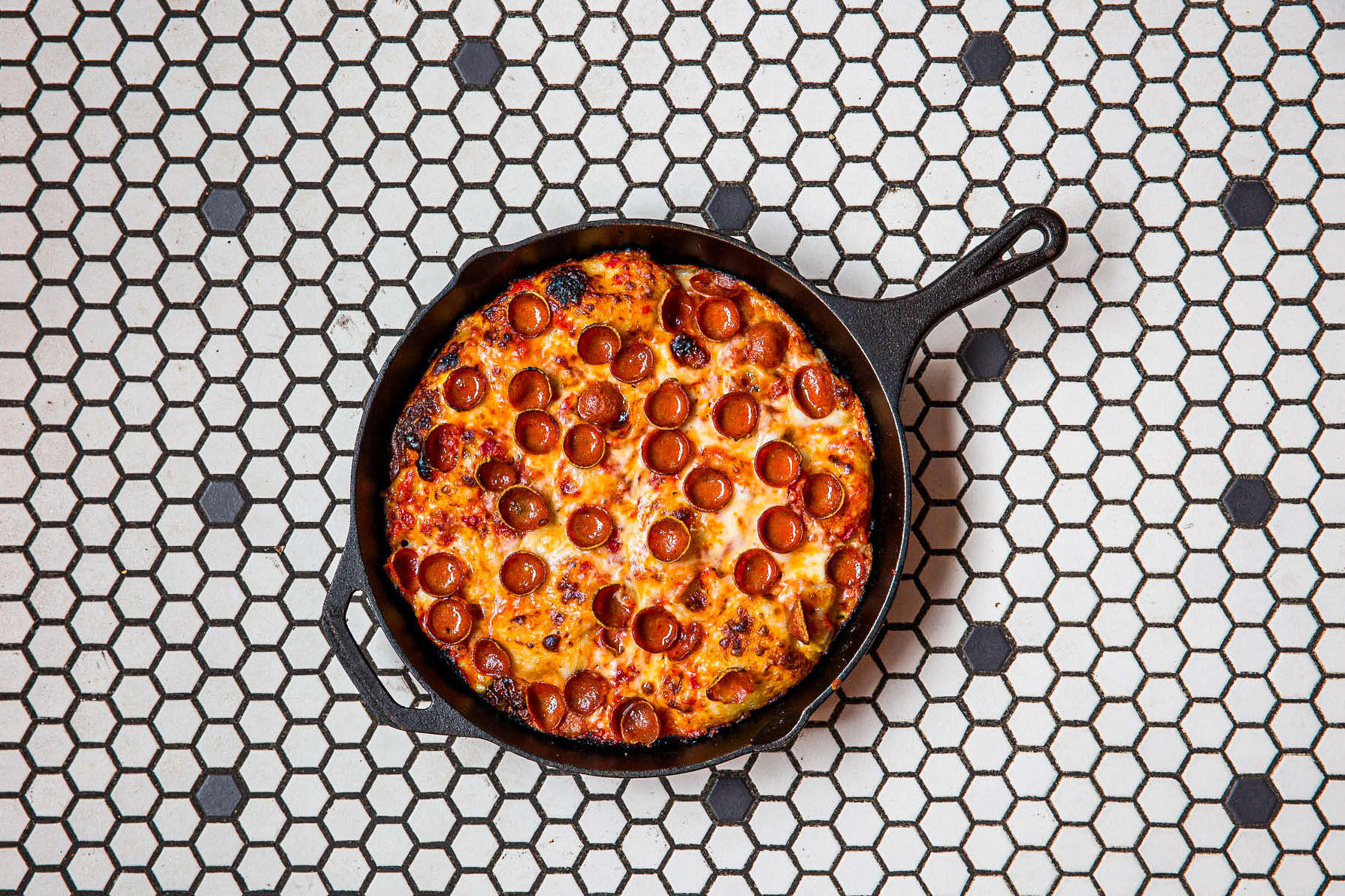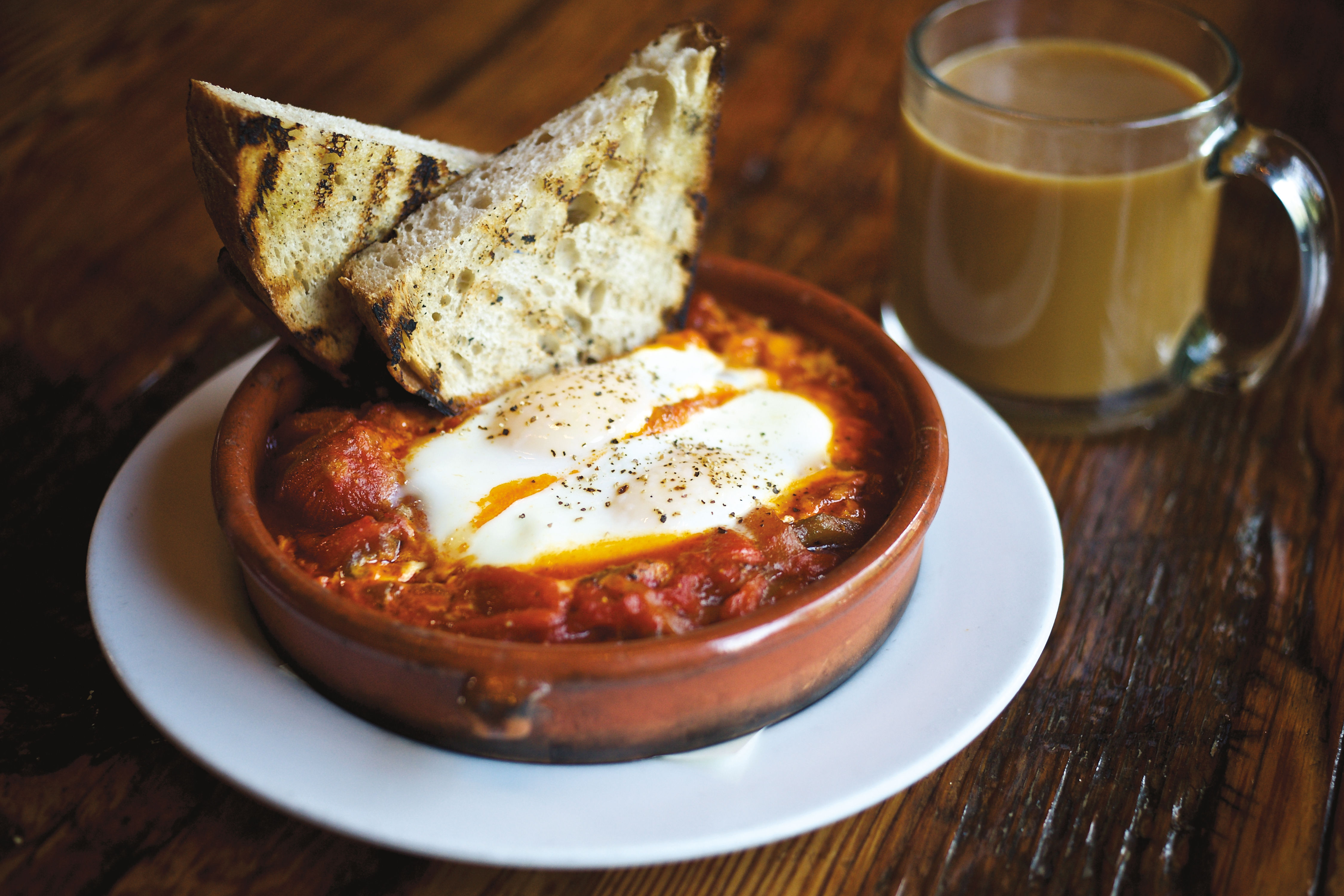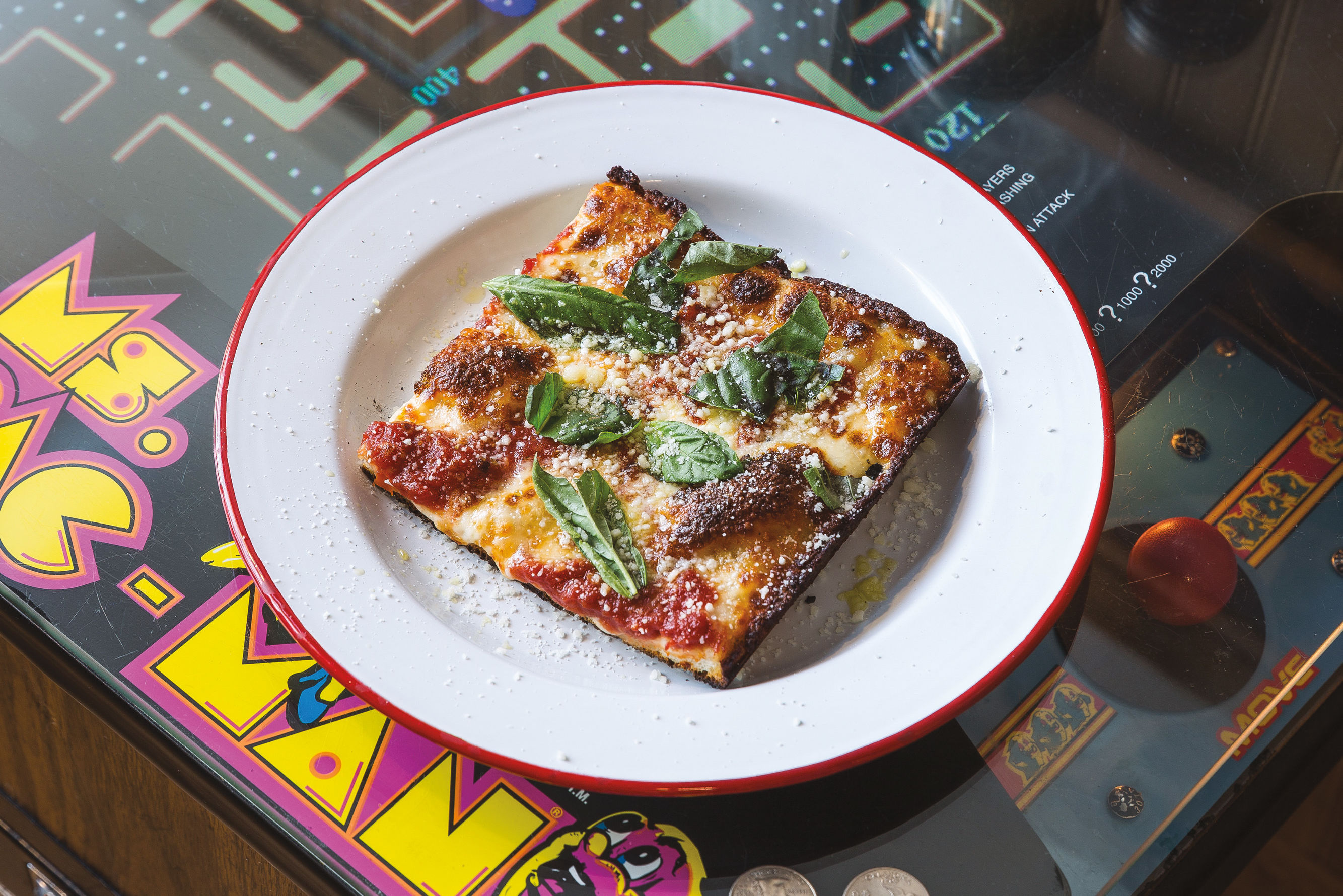
New York. Chicago. Detroit. Portland? Making the Case for a New American Pizza City
This is Portland pizza. Sarah Minnick barrels down I-5 last summer, fast and furious, homebound from a conference on Cascadian grains in Mount Vernon. She can’t wait to get back to Lovely’s Fifty-Fifty, her North Mississippi Avenue restaurant, a sort of locavore pizza think tank. In the backseat: a cache of multicolored snapdragons. Flour to flowers, what grows around here drives Lovely’s strange and wonderful flavor expeditions. Who puts snapdragons on pizza? (Who puts snapdragons on anything?) But Minnick is lost in a reverie. “Snaps, man, they’re really hard to explain,” she says when I happen to cold-call in the moment. “A little sweet, a little rosy, very floral.” Her plan: confetti them over a bacon cheese pizza—a princess birthday party, with pork.

Scottie‘s Pizza Parlor owner Scottie Rivera
Image: Stuart Mullenberg
No, this is Portland pizza: Imagine Sunday-night lasagna. Your sister in curlers. Robert De Niro’s unhinged Johnny Boy dancing to “Mickey’s Monkey.” It’s not your life; it’s Martin Scorsese’s. But it is the Defino pie at Scottie’s Pizza Parlor: a moment that crackles, alive with tactile pockets of baked cheese (pictured at top). In the pizzeria of macho Gotham fantasy, you imagine an oven guy built like a Lucchese foot soldier. Scottie Rivera, the 28-year-old owner here, is a sprite in pizza socks and an apron emblazoned with the words “Pizza Mania.” Yep, you’re in Portland, down the rabbit hole on SE Division Street. The kid studies pizza theory like a paleontologist puzzling over what ancient animals might have looked like. During a 10-year quest, he distilled 1970s New York, Mean Streets New York, into pie form. No one gets a crust like this. But you won’t find Sinatra or DiMaggio on the shop’s “Wall of Fame.” Rivera enshrines his own idols, Julia Child and Ruth Bader Ginsburg among them. He also loves New Mexican green chiles.
Wait, this is a Portland pizza: Pizza Hut meets No Reservations. Blunt included. That’s just the rough outline at Pizza Jerk. During the shop’s short history in Northeast, Tommy Habetz and friends have tossed Portland’s indie ethos into a punk-rock pizza joint for families: studied, stoner-satisfying pies, with Fugazi and grade schoolers raging in the background. Pizza Jerk pies often seem to bring all the threads of the city’s interconnected food culture together in 18-inch beasts.
Take the “Thai pizza.” The lore I’ve heard traces the pie’s DNA to a random joint in the jungle outside Chiang Mai, the city that often inspires Andy Ricker and his famed Pok Pok mini chain. Ricker discovered lemongrass-singing northern Thai sausage—vibrant, coarse, and funky. Olympia Provisions now produces it, an epic Portland collaboration to begin with. Next chapter: JB Tranholm, once Ricker’s right hand at Pok Pok, is now Pizza Jerk’s “chef de cuisine.” (Yes, this is a red-checked-tablecloth joint with retro video games and a head chef.) He gives this very Thai thing a new identity, crumbled with fried shallots, hot chiles, and basil over a buttery crust ripped from Habetz’s Connecticut youth.
You can’t make this stuff up. It’s Portland pizza.
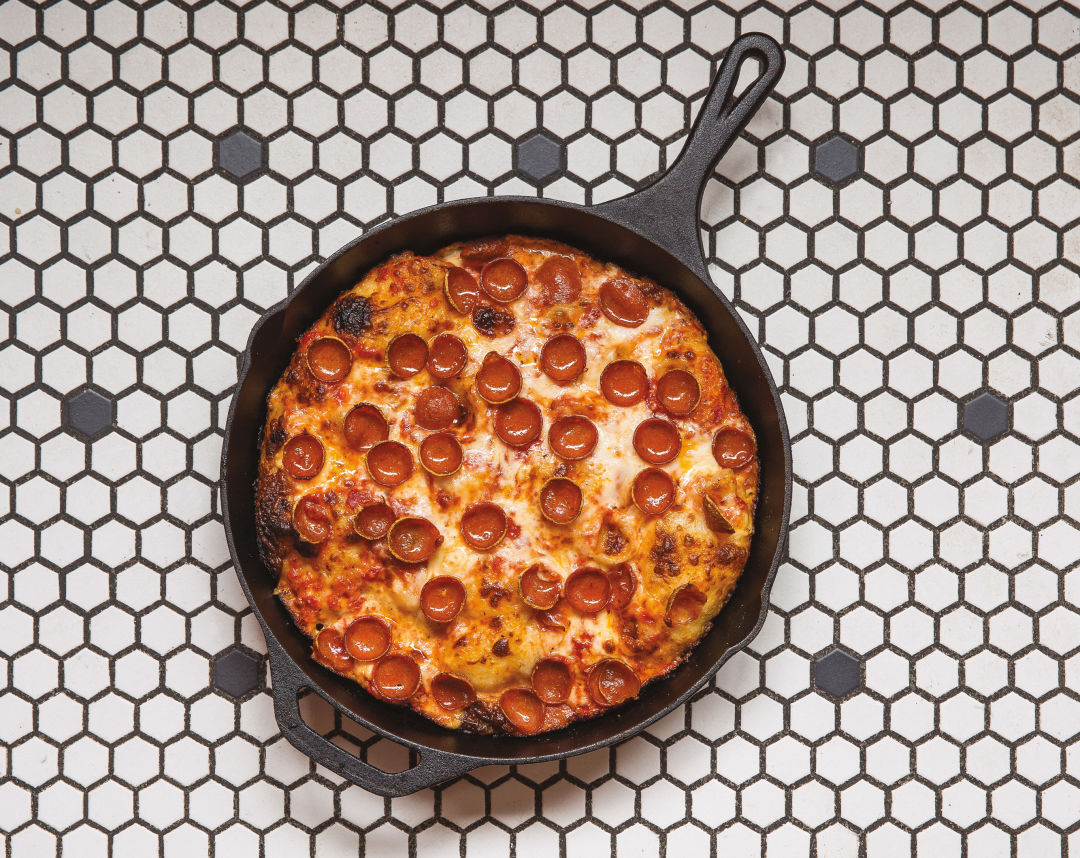
Pizza Jerk’s cast-iron pepperoni
Image: Stuart Mullenberg
As it turns out, Portland pizza is many things, beholden to no doctrine, only to open minds and a willingness to get serious about quality. That it’s even worth talking about is a recent development—Portland used to be a pretty sad pizza town. A few great pies busted out over the years. But mostly, veggie pizzas heavy enough to mug Luca Brasi ruled the day.
The city’s collective dough is rising at last, with a voice and unmistakable taste of place. Portland might even be America’s most original pizza destination. (No, I’m not saying it’s better than New York, so sit back down and put your head on your desk.) I’ve been on a pizza bender recently, thinking about all this, checking in on the places defining a very local slice.
At Lovely’s, Minnick has emerged as the Alice Waters of pizza, with a near-spiritual connection to Oregon’s most adventurous farmers. She builds toppings from whatever they drop off—stinging nettles, quinoa greens, maybe bok choy raab, backed by unusual regional cheeses. Lovely’s makes its superb sourdough crust with locally milled grains that change with the season. The results may not be pizza as you know it. But I’m embarrassed for most other pies when I dig into one of these chewy, sour, flavor-rich wheels, and I may not be alone. Minnick recently shared a stage at a food conference in Milan with Franco Pepe, the pizzaiolo behind Pepe in Grani outside Naples, considered perhaps the world’s greatest pizza shop for its profound evocation of land and place. After finding kinship with Minnick’s philosophy during a Portland visit, Pepe invited her to collaborate on a “double onion” pie. They communicated with their hands and beloved ingredients. She’s now learning Italian to talk to him.
Meanwhile, Habetz, once a protégé of New York Italo-imperialist Mario Batali, later cofounder of Bunk Sandwiches, has found his destiny as something of a pizza genius. Few places have an old-school/new-school/out-of-my-mind game like Pizza Jerk. Where else can you order a half-and-half that combines major-league pepperoni and a Chinatown-riffing dan dan pie? Jaded Bon Appétit called the Jerk “America’s Pizzeria of the Year” for 2016.
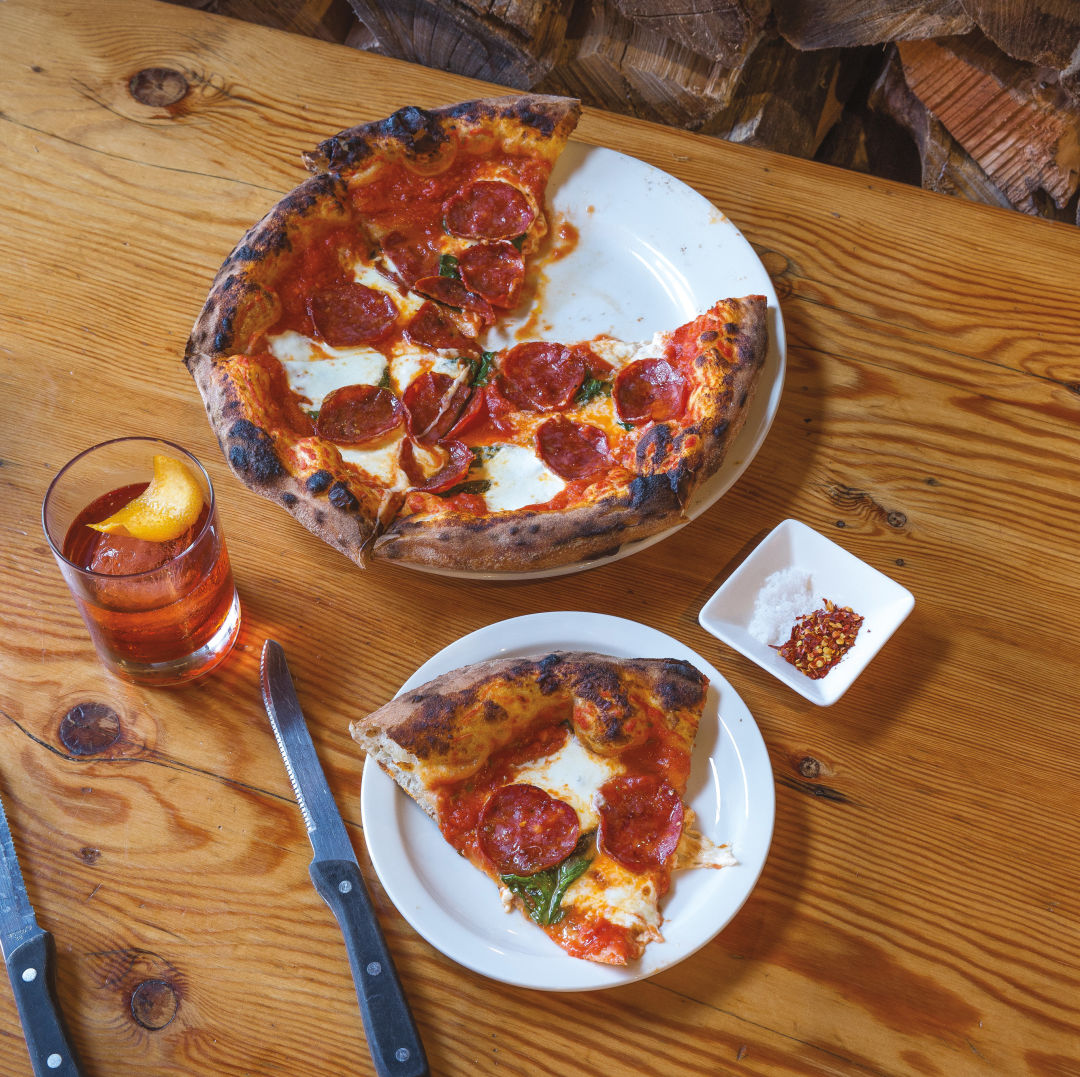
Wood-fired pepperoni at Ken‘s Artisan
Image: Stuart Mullenberg
Also reaching peak Portland pizza: Ken Forkish, who pioneered his own Italy-meets-French-boulangerie style on the east side 11 years ago. Ed Levine, founder of the popular New York–based blog Serious Eats, calls him “one of the world’s great pie men,” and, when you eat a spicy soppressata pie at Ken’s Artisan Pizza, it’s hard to disagree. No bones about where his heart lies—these 12-inchers demand engagement with their rustic crust. Forkish’s recent scholarly book, The Elements of Pizza, is a must for home cooks hoping to pass for pros. For him, a New York immersion was not just book research but a challenge, and last year he opened downtown’s Trifecta Annex to prove it. “I’d put our slices against any in New York,” he told me recently. After a slow start, I must say they’re darn good, thin and crispy in all the right places.
Some of Portland’s pizza makers channel East Coast heroes through an Oregon bread baker’s heart, which is why our dusky, muscular rims often taste like exaggerated ciabatta. Apizza Scholls, founded in 2005 with roots in an earlier sourdough bakery, still protects its dough art like a samurai warrior: no more than three ingredients, no phone orders, no screaming kids, nothing to detract from the sheer enjoyment of a beautiful neo-Neapolitan crust. The place can be a pain, but you can’t help respect it: the super-creamy ricotta pools, the tongue-size bacon. The menu rarely changes, so it’s easy to forget that seven nights a week, arguably one of America’s top 20 pizzas is emerging from an electric oven on SE Hawthorne.
Superstars aside, legit pizza has spread to all corners of the city. Neighborhood spots like Concordia’s Red Sauce (family game boards, springy-crisp dough, house meats), NE Killingsworth’s Handsome Pizza (exploring whole grains), and the East Glisan Pizza Lounge (home of the meatball pie) are budding enthusiasts to watch as they dig into their own niches. Southeast’s Renata found a groove in San Franciscoesque pies marked by good char and big flavors. At Scottie’s, Rivera is the up-and-comer, with straight-up thin crust, bright sauce, homemade everything, and a classic slice menu: pepperoni to margherita to bianca.

Sarah Minnick piles on at Lovely‘s Fifty-Fifty.
Image: Stuart Mullenberg
And who knows what will come of the new Heart Pizza, from zeitgeist-savvy entrepreneur Micah Camden (Blue Star Donuts, Little Big Burger) and his gifted, how you say, emotional chef Morgan Brownlow? Except this: it’s gonna be interesting. Two of the city’s most complicated personalities are joining forces on a venture inspired by Brownlow’s cooking at one of Portland’s most exciting and fraught restaurants ever, Clarklewis. Multiple locations are already in play, testing a new model: fast food meets cheffy wood-fired pizza, ready to go in mere minutes. Early versions are still in shake-out mode, but I enjoyed—on many, many levels—an effort called the Peasant pizza, an ode and a wink to Clarklewis’s legendary salad of chicory, walnuts, and pancetta.
Over in the ’Couv, Forkish’s longtime oven man Alan Maniscalco makes his mark at Rally Pizza, keeping things more playful than his former boss (a meeting of Canadian and belly bacon: the Piggy Back). It’s one of several artisan projects north of the Columbia. The most fascinating sits in a blue trailer in a Hazel Dell parking lot bordered by abandoned buildings that look like remnants from Hurricane Katrina. Inside, as a little fire rages, a Japanese guy trained in Sorrento makes true Neapolitan pizza, besting any challengers in Portland. In this unlikely corner of the metro area, 43-year-old Daisuke Matsumoto uses only fine-grained doppio zero Caputo flour, paying close attention to the fundamentals of flash-fired Naples dough. At last count, he was laying as many as six slices of La Quercia prosciutto on an $11 pie. Customers tailgate in the lot. If the romance of food is a state of mind, this cart with the operatic name Pizzeria La Sorrentina captures it.
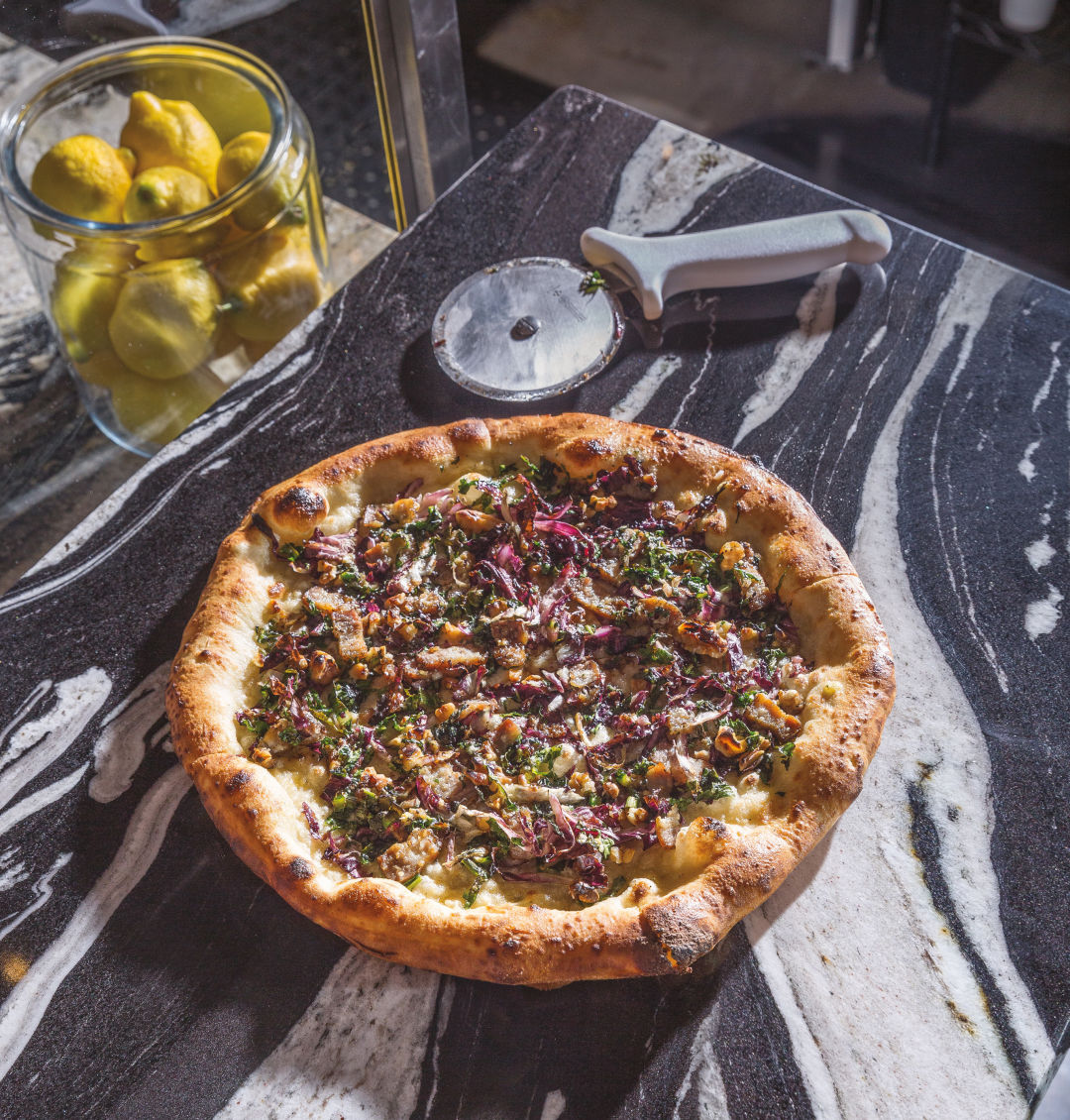
Heart Pizza‘s Peasant pizza
Image: Stuart Mullenberg
All this is merging into a quantifiable style, even if harder to explain than the taste of snapdragons. Typically, a regional pizza genre—Detroit’s gooey, cheese-crispy squares or New Haven’s coal-charred ovals and rectangles, say—is defined by a set of shapes, thickness specifications, and baking methods, highly codified and endlessly replicated at local shops. They inspire biblical feuds over origin stories and “authenticity.” Stumptown’s pizza is the opposite. No two joints are alike. Portland has no prescriptive, handed-down food culture, so our pizza makers freely sample American styles and the Naples mothership, adding personal choices and oddball preoccupations, adhering to our unofficial food motto: no idea forbidden.
In the end, commitment and originality are the litmus tests at these self-created schools. Only slackers aren’t making their own mozzarella. If you’re not tapping world-class Oregon produce, go home. Foragers and growers are adding to the mix. Sure, you can find a fine sausage pizza here. But at Lovely’s, just for example, you can dig into fresh sheep cheese and nostril-flaring “green-in-snow” mustard greens, bred by a farmer specifically to thrive in Oregon’s rainy chill. It can send a shiver down your spine.
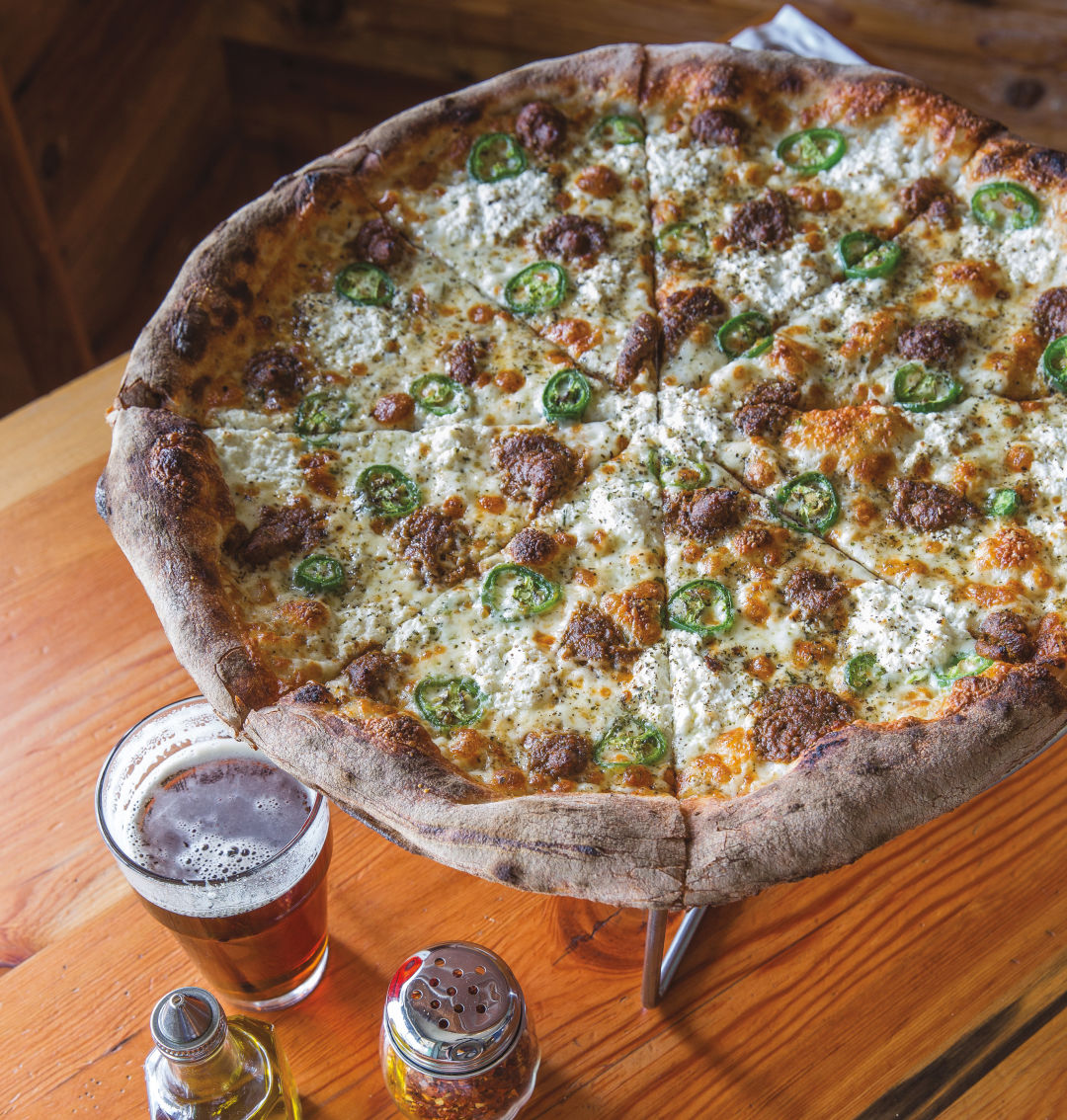
Apizza Scholls' diablo blanco
Image: Stuart Mullenberg
The founding father behind our declaration of pizza independence is surely Mark Doxtader. In 2001, the guy had never laid a brick when he decided to build a massive wood-burning oven in the back of his pickup truck and haul it to the Portland Farmers Market. On day one, at about 4 a.m., his father drove behind him to the downtown site, packing extra mortar in case disaster struck. Hours later, Doxtader lit a fire with fresh-chopped wood; when the coals burned brightly, he laid down a vision of flatbread and apples from his farm 30 miles south. He called it Tastebud. The combo tasted like smoke and earth. It tasted like playing your own damn music. It tasted like the future of Portland pizza.
Tastebud would birth a Multnomah Village restaurant, where staffers top pies with dill pickles and peaches. But far beyond his oven, Doxtader’s influence can be felt across town, from Lovely’s to Pizza Jerk. Consider Tommy Habetz, on track to be Batali’s disciple when he moved here in 2002. For a hard-core East Coaster, Portland pizza was unworthy, “hippy dippy,” as he once put it. (He wasn’t wrong.) One day at the farmers market, he happened on Tastebud’s apple-laden sausage slice.
It was one moment in a journey to Habetz’s self-discovery. He learned to trust himself, his tastes. Doxtader, he says, helped set him free. Most pizza shops look to respect tradition or jump on bandwagons. The overriding impulses of a Pizza Jerk pie are basically “What is Tommy craving?” Korean barbecue, apple pie, lamb sausage and mint, roasted beets and goat cheese, even a vat of creamy, al dente penne alla vodka have gotten the Jerk treatment.
The Jerk’s latest passion is Detroit style, sort of: deep-dished and über-cheese-crisped in a cast-iron pan. It’s as American as a pie gets, like eating a loaf of bread, over grilled cheese, and adding a refrigerator binge—so wrong and yet so right. Daily options are available, but ask and they’ll make any pizza the cast-iron way. No house rules. Sure, edges can be too burned; experiments might fizzle. Other places may have the consistency thing down. Pizza Jerk takes us into the mind of a chef. Maybe—like all these mothers of inventions, these avatars of self-expression and keepers of the flames—it may even give us a glimpse into our soul.
“I so want a mezza pizza,” Habetz moaned recently. I hope he follows through. That would be Portland pizza.


